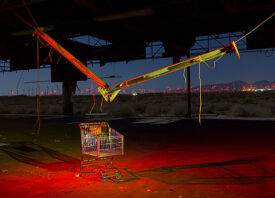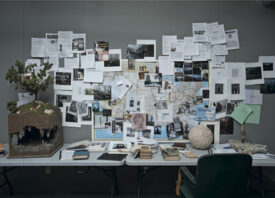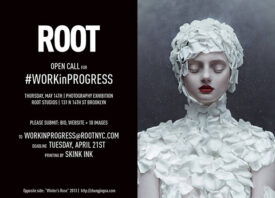Search this site
11 Night Photographers on Mischief and Magic After Dark

During the day, the camera sees what we see, but at night, it can record things that are completely invisible to the human eye. Photographer Michael Kenna once put it this way: “Film can accumulate light and record events that our eyes are incapable of seeing.”
In the darkness, everything that was once familiar becomes alien. Photographers who choose wandering over sleep grow to understand the strange, parallel world that emerges under the moonlight, and every frame they bring back with them has a story behind it.
We asked eleven of our favorite contemporary nighttime photographers to tell us tales of mischief, serenity, suspicion, and triumph after dark. Some are breathtaking and dramatic; others are understated and sublime.
Troy Paiva: After almost 30 years of sneaking around at night in abandoned hospitals, decommissioned military bases, and aircraft boneyards, specifically to take weird moonlit pictures, I have endless stories about close calls with venomous snakes and insects, packs of wild dogs, angry cops, tweaker metal scrappers, and wasted teens run amok, but having a gun stuck in your face is hard to top.
The night before teaching a workshop in 2012, one of my students took me to a remote Mojave desert ghost town called Cantil. All that’s left are a few buildings, including the Post Office, seen here in this photograph, Postmarked by the Moon.
After shooting for a few minutes, a figure approached out of the darkness with a shotgun: “I gotcha covered! Yer trespassin’; get outta here!”
I quickly shined my flashlight at my tripod and gave a friendly, “Howdy! We’re just photographers!”
He handed the canon to his wife, who was a few yards deeper in the shadows holding another gun on us, and then he approached me. My heart was in my mouth those first few seconds, but I quickly showed him some night pictures I keep stored on my phone, and within minutes, it was like we were old pals.
Turns out, he’d lived in the town’s old schoolhouse for decades and had run off countless vandals and scrappers. He allowed us to stay and shoot as long as we liked.
This is not the first time I’ve had a gun pointed at me as a night photographer. If you do this kind of work long enough, it’s inevitable. Usually it has a happy ending like this, but I’ve also had to quickly grab my tripod and run back to my car.

Ignas Maldziunas : I found this abandoned aircraft on Google maps and got obsessed with the idea of taking a picture of it. I went to Indonesia and found that airplane, and it was secured by fences and guards.
I started to look for a way to get into the territory at night. After a few weeks of trying to contact the right person, all I got was a firm “NO,” so I decided to break in. I had no crew and no plan, so I hid in the bushes and observed.
Not long after midnight, I saw a woman sneaking out from the hut at the entrance. A minute later, a drunk security guard left the same hut. I saw them getting on bikes and leaving the territory.
That was my chance. Through the jungle side, I went inside and set up the camera. When I work with my flashlights at night, you can see hundreds of flashes from miles away, so I’m always prepared to meet curious people at any point. It makes my work bit stressful. But that night I was all by myself running around for hours. It was around a four hour exposure, with fog coming and leaving.
I came back completely exhausted with only one picture on my film. It became one of the most precious photographs I’ve ever made.

Marilyn Mugot: This picture is one of the first I made in Hong Kong during my trip to China. It’s always magical for me when I arrive in a new place that I don’t know. Everything is new, and I have the impression that the city is full of secrets. When I arrived, I was awakened by Hong Kong. The change of scenery was intense and pleasant but also a little bit scary, especially because I travel alone without knowing anyone in the countries I visit. When taking this picture, the sun went down slowly after a few hours of walking. The weather was good and warm, and I was very happy to be where I was.

Jordi Huisman: I’ve been shooting my Rear Window series at night for a couple of years now. I was in Rome in 2012, working on the series. During the day, I’d walk around the city looking for spots that were accessible and suitable to photograph during the night. It’s a necessity to be able to take the pictures from above ground level.
In the back of my hotel, there was a nice courtyard with a one-story building in the middle. I found a small wall in the back where I could get up on the roof, and so I returned at about 10:00 PM with all my gear. I brought my passport just in case. After I spent an hour on the roof, taking three pictures, I climbed down again.
All of a sudden, three people came towards me from the alley where I was headed. As it turned out, they were Carabinieri wearing bulletproof vests, heavily armed with loaded machine guns. They started shouting in Italian, and I replied in English saying that I didn’t speak Italian.
They’d received some calls from the people in the apartments I photographed, who thought I was a sniper posting on the roof. My tripod and 4×5 camera must look very threatening in the dark! Luckily, I had already sort of thought about such a scenario, so I could explain to them relatively calmly what I was doing. I showed them my camera and the pictures from Amsterdam and Paris on my phone.
Despite the fact that they were very hyped with adrenaline, they just let me go after checking with the hotel manager to make sure I was actually a guest there. The pictures I took on that roof weren’t usable for the series, but I got a good story out of it.

Danny Rowton: It was a Saturday night, and I was alone at home with no particular plans. It was about 11:00 PM, but I decided to go out in the cold with my camera and tripod and shoot instead of watching the football highlights and chugging a few beers. The shot was not bracketed, despite the clear prospect of error, so this shot was the only one taken of the scene. This also makes it feel a bit more special.
To me this scenario is a microcosm of what photography can be about. Perhaps it’s a cliché, but it’s a reminder that I reap what I sow. It’s easier to relax on the sofa, but to get good images takes a degree of sacrifice. This picture now hangs on a gallery wall in Bowen Island, Vancouver, having been chosen for a showcase of emerging film photography talent and serves as my first international break.

Jan Staller: The photograph was made in 1996 at a construction site in lower Manhattan. I was intrigued with this peculiar “monument” which was actually an ongoing test of pilings in the landfill along the Hudson River. I had asked the appropriate authorities if I might make photographs of the site.
As is so often the case, permission was denied, but I just could not let go of the idea. I had to make this image!
Photographing at night back then required a tripod and lengthy exposures, not to mention that at that time I was also lighting my photographs with powerful metal halide lamps such as the ones used at sports stadiums. Making my photographs involved an extended period of time to set up camera and lights and to subsequently make a succession of exposures. Photographing this site would require more than simply sneaking on site, snapping the picture and making a hasty retreat.
It was one of those long summer days. With an assistant, I drove down and parked my Land Rover at the site hours after the construction crews had left for the day. We donned hard hats that I often kept in the car for similar situations and proceeded to set up the light. At dusk, I started the car, powering up the engine mounted generator. Within a few minutes, the metal halide bulb had reached its full intensity, flooding the site with light. There would be no way that my presense would go unnoticed. I then slipped though a gap in the fence to begin photographing, while my assistant remained outside with the car, communicating with me by walkie talkie radios.
Within minutes, she radioed me that a watchman had come to ask what were we doing. I told her to send him in and I would talk with him. He asked the same question of me, to which I replied, “photographing the subsidence of the pilings.” This dialogue ensued as I continued to expose and wind my Hasselblad:
He: “Are you working for the contractor?”
Me: “I’m not here for the fun of it.”
He: “No one told me about this.”
Me: “No one called from the office?”
He: “No.”
Me: “I don’t know why they didn’t notify you. They just told me to come and make photographs.”
He: “I’m going to have to make a call.”
Me: “Ok.”
Before he was able to find out that I was trespassing, the sky had sufficiently darkened, and I knew I had what I needed. I told him I was finished anyway. I grabbed my camera and tripod and withdrew to the outside of the fence. We loaded up the lights and equipment and drove off.

Amanda Friedman: This particular image- Cobbs Hill, Rochester, NY– holds a special place in my heart as it was basically the first image to kick off my Night Landscape series. I had no idea at the time that this shot would turn into a fifteen year project. That night, it was really foggy, which turned the city into this surreal landscape. I grabbed my Rollei Twin Lens Reflex camera and went out and shot about six rolls of 120 high speed film. When I got the proofs back, everyone was “oohing and ahhing” over them, specifically Cobbs. The response was overwhelming, so with that, I continued shooting!

Dave Jordano: I’ve been working on a series of night images in Detroit for the past year that compliments my previously finished project, Detroit: Unbroken Down. I honestly have to say that very little happens during these night visits, and that is what I actually enjoy about them. The quiet, contemplative nature of working at night helps to provide a bridge between my desire to show the city as a living, breathing, urban environment, and to debunk the perception that it is a place that is too dangerous to venture into. The pace is slow and time seems to arrest itself.
What surprised me about this particular image was how the long 30-second exposure created the forceful diagonal cloud streaks in perfect alignment within the structure of the composition. It was an “OMG” moment when the image popped up on my camera’s preview screen. It was something that was totally unexpected. I knew immediately I had an image that was special.

Patrick Joust: This photo was taken on a really great night for photography. I was out with my friends and fellow photographers Josh Sinn and Bryan Vana just a couple weeks after my son was born four years ago. All three of us got beautiful shots that night, reflecting our own points of view. I had the sense that night was almost a benchmark for what a good night of taking pictures could be. This shot, taken with my highly pocketable Olympus XA, with its special diamond bokeh, was one of my favorites. Everything just seemed to come together.

Josh Sinn: I was out shooting photos one foggy night with Patrick Joust and Bryan Vana. We parked in this Baltimore neighborhood and started to explore on our own. This house caught my eye because of the car in the driveway and the basketball hoop. It wasn’t a incredibly great scene, but it was worth taking at least one photo. I shoot my photo while Bryan was loading his camera next to me, so we just chilled in front of this house for a few minutes.
This man walked down the sidewalk, looked at us, then proceeded to go up to the door of the house I just shot, which made me a bit nervous because people can obviously get protective of their property. The owner answered the door and let the person in.
Maybe a minute later, the owner came out yelling, asking what we were doing. We reply with the usual “we like fog and old cars,” which he didn’t believe. He repeatedly asked us what we were up to, and we kept saying the same thing. It was almost comical at this point. He then said, “I’m gonna get my dog and ask you again”.
He comes back out with a Chow Chow. The dog was barking and he was yelling, and that’s when Patrick stumbled upon us and immediately called the police. Bryan calmly explained again what we were doing and somehow got the man to relax a bit. He proceeded to tell us that his car’s rims have been stolen several times before and that was why he was so protective. His girlfriend was less understanding and still yelling at us from the doorway, so we decided to wait in the car for the police.
They never came so we left. Could have been much worse.

Sergio Chiaramonte: This shot was taken at the end of a long visual inspection around the chemical industry north of Milan on a cold winter night. This picture represents the synthesis of my photographic work, characterised by the theatricality, the absurd, the mystery, and the research of geometric shapes in the urban landscape. Aware of having found an important image, I tried to include in this shot all the elements in order to communicate my thoughts. I hope I reached that goal.

Paul Thompson: This shot was taken in a small village called Powfoot, which is situated in Annan, Dumfriesshire. The village sits along the Solway Firth Estuary, which leads to the Irish Sea. The Solway Firth is the second most powerful estuary in the UK and one of the most powerful in Europe.
The Solway Coast has an abundance of natural landscapes and is renowned for its spectacular sunsets. The masts across the water are situated in the remote village of Anthorn, on a blunt peninsula thirteen miles west of Carlisle. The village was once home to a busy, thriving Naval air-station.
The site is now a Very Low Frequency (VLF) transmitter station, which is used for transmitting orders to submarines. The time signal, which was broadcast from Rugby for many years, is now broadcast from the VT Communications site at Anthorn. The best known manifestation of the NPL time signal is the BBC’s “pips,” but it is widely used in the transport and financial services sectors, among others.
The history of this location is one of the reasons that I was drawn to making a picture here. While the masts may be regarded as ugly within the landscape, at night and over such a long exposure, they actually create a beautiful, surreal, and eerie atmosphere to the landscape. The rocks in the foreground over the tidal change, combined with the reflections of the lights from the masts, create a futuristic/sci-fi landscape.
Due to the nature of my Moonlight project, the exposures range from anything from one hour to three hours per image in exposure. During this time, I experience many changes in weather, tide, and light. Everything is shot on a large format plate camera on film. This was shot on a September night, so the weather was just starting to turn. It was a beautiful evening, very calm and peaceful, the clouds were almost still.
As I started making this picture, the tide was way out, but I had no idea how quickly it would come in. I remember I had to keep an eye behind me to make sure I didn’t get cut off by the tide. By the end of the exposure, the tide was just at the feet of the tripod. I really felt like I’d captured something that I would be proud of, but I didn’t know for sure. I had to wait over two weeks to return to London to process the film to find out.


